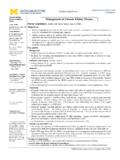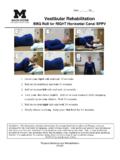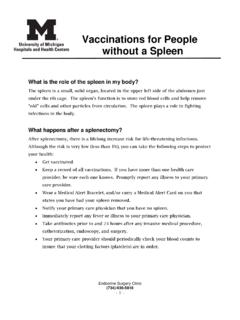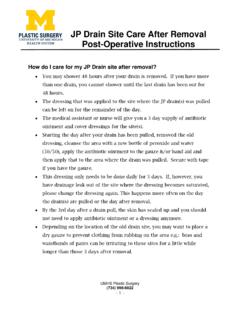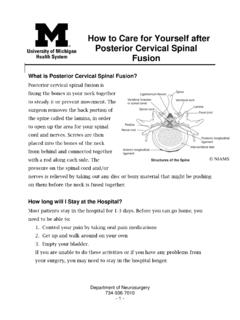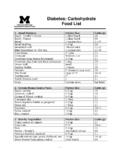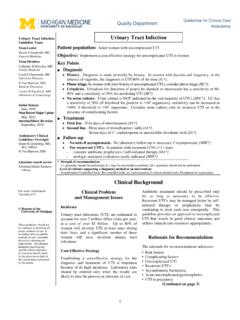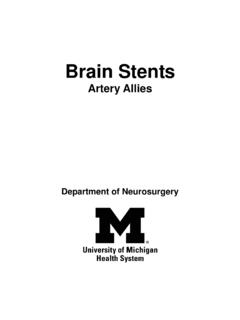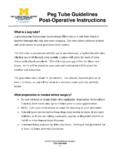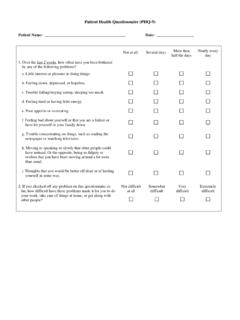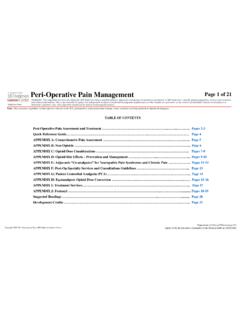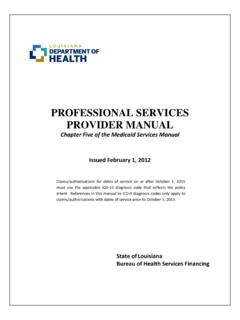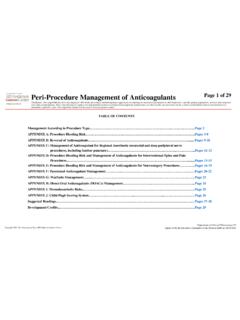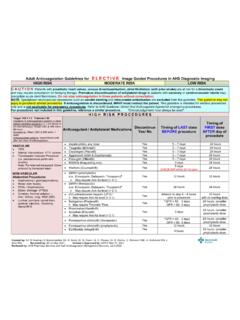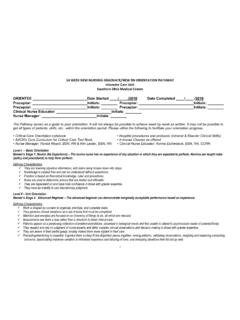Transcription of Peripheral Nerve Catheter Pain Management Therapy: …
1 Department of Anesthesiology 734-936-4280 - 1 - Peripheral Nerve Catheter pain Management therapy : what is it? what is a Peripheral Nerve Catheter ? A Peripheral Nerve Catheter is one way to relieve pain at the site of surgery. The anesthesiologist will place a small hollow plastic tube ( Catheter ) under the skin into the space containing the nerves that provide feeling to the area where surgery will be performed. This will be done before you go into the operating room. How much pain relief should I expect? The goal is for the Peripheral Nerve Catheter to take the edge off your surgical pain . Some patients pain control is better than expected, and others worse. The team will make every effort to maximize your pain control after surgery, including using other types of pain medication as needed. what will happen on the day of surgery? You will come in early for your anesthesia evaluation and to allow enough time to place your Catheter .
2 We will ask you several questions about your health and anesthetic history and then give you a sedative through you IV. A member of our team will clean your skin. The doctor will use an ultrasound machine to look at your nerves. Once they are located, we will numb your skin and the doctor will place the Catheter under your skin near the nerves of interest. what medicine will I be getting through the Catheter ? The Catheter will be used to continuously transfuse local anesthetics (numbing medicines). The medicines will cause some numbness in the area of surgery and reduce An anesthesiologist is a medical doctor who specializes in giving drugs to control pain before, during, and after surgery. Department of Anesthesiology Peripheral Nerve Catheter pain Management therapy : what is it? - 2 - your pain . Your surgeon may also prescribe pain medicines to take by mouth after your surgery. How does the infusion work?
3 The Catheter is connected to a bottle with a balloon of local anesthetic inside of it. If you are in the hospital the Catheter will be connected to a pump. The balloon, or electronic pump, pushes the local anesthetic through the Catheter continuously at a pre-determined rate. How long will it last? On the day of surgery, we will give you a strong local anesthetic through the Catheter . This will last around 12-18 hours. When it wears off, the medicine going through the Catheter will not be as strong. You will feel some return of sensation at this time. If it is too uncomfortable, you will have medicine that you can take by mouth to help relieve your pain . Local anesthetic solution will be infused for one to three days longer through the Catheter . Some amount of numb feeling will last for a few hours after the Catheter infusion has been discontinued How does the Catheter come out? Once the infusion is complete, or when it has been stopped, you must wait 12 hours for the effect of the local anesthetic to wear off.
4 Once you have return of sensation, you simply take off the bandages over the Catheter and remove it. The Catheter should come out very easily. We will give you more detailed discharge instructions after your surgery. Care of you Catheter at home You must keep the dressing over the Catheter clean and dry. You must also take care to protect an extremity that is numb by keeping it close to your body and avoiding very hot and very cold objects (heating pads, ice packs) as they can damage your skin without you being aware of it. We will explain this in more detail during your discharge. You should sit down to remove your Catheter and/or have a family member assist with removal. Department of Anesthesiology Peripheral Nerve Catheter pain Management therapy : what is it? - 3 - Disclaimer: This document contains information and/or instructional materials developed by the University of Michigan Health System (UMHS) for the typical patient with your condition.
5 It may include links to online content that was not created by UMHS and for which UMHS does not assume responsibility. It does not replace medical advice from your health care provider because your experience may differ from that of the typical patient. Talk to your health care provider if you have any questions about this document, your condition or your treatment plan. Authors/Reviewers: Andrew Dering, MD; Paul Hilliard, MD, Mohit Rastogi, MD; And Susan Holmes-Walker, PhD, RN Patient Education by University of Michigan Health System is licensed under a Creative Commons Attribution-NonCommercial-ShareAlike Unported License. Last Revised 9/2014 When do I call a doctor? You will receive a phone number and pager number with your discharge instructions. We will also explain what signs and symptoms should alert you to contact an anesthesia provider. While you Catheter is in place, a doctor will contact you each day to make sure your pump is working safely.
6 Do you have more questions? Call the hospital operator at 734-936-4000. Ask to speak to the Acute pain Resident or Nurse at pager # 9031.
